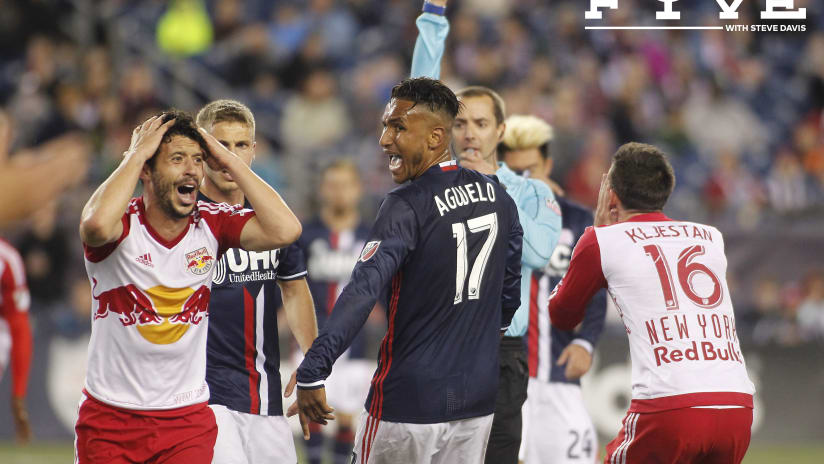1. There is no “red card” problem; there is a “narrative” problem
Everybody and their border collie has written about red cards in MLS. So I won’t fall in line here; I’m not writing about red cards in MLS.
Instead, let’s talk about bad narrative … as it relates to red cards in MLS! Because bad narrative carried this conversation – and probably carried it down rabbit holes. Card-carrying journalists (I’m raising my hand here) should be committed forever to stomping out bad narrative. With both feet.
The problem is that it’s just so easy to glom onto bad narrative. Bruce Arena got things started Saturday by suggesting the game was being torn asunder with red cards. Seems there’s one every game, he declared! Well, not true; it’s a tick above one in three games so far.

Either way, Arena empowered or encouraged some other voices (players, supporters, media) to weigh in and, pretty soon, everybody accepted as fact that red cards were way up and that MLS players were unable to untangle what did or did not constituted a bad foul.
Well, there are kernels of truth to it – but also a lot of bad information afloat. So let’s drop a bucket of hard data and common sense over this barn fire of toxic narrative.
First, Arena helped light the fire. Now, the guy is an unbelievable MLS manager, habitually ahead of the curve in navigating the league’s tricky player personal corners. But he’s also a famous curmudgeon! If you handed Arena a free burger and fries, I am convinced he’d complain that you didn’t pick up a shake for him, too.
As for the players who say they don’t understand what constitutes a bad foul, well, league leaders have been pretty clear; there were areas of emphasis this year, including cracking down on dissent and reeling in the percent of red card-worthy fouls that escaped attention. It’s on the players to adjust.
Then came the data. Somehow it got reported that red cards were up by a factor of 3x. Only, that’s not true. As these numbers show, it’s up only slightly from last year and not that far above historical averages.
Here’s some context (“context” typically being the enemy of lazy journalism and bad narrative): We have this conversation, early in the season, in a lot of years. It’s almost an annual rite; happens in late March or early April.
Eventually, players and coaches adjust to the particular emphasis of the season and things stabilize.
You know what other conversation we have every year? It’s the one where players aren’t being properly protected. That one is coming, too, and here’s the number to keep in mind: Last year, reviews from PRO assessed that 28 percent of fouls that warranted red were missed.

2. Kaka … yes, please, we’ll have more of that
Kaka’s performance in Orlando City on Sunday evening was nothing short of a master class.
Here’s a good breakdown of the Brazilian attacker’s night. Or, you can let me sum up: he was everywhere, running the attack, providing key passes, assisting here and there on recovering possession and generally being the man Flavio Augusto da Silva and his Lions’ ownership group wanted when they signed him.
He’s the guy who will help fill that swell new stadium next year. Assuming he stays healthy, that is. And that’s the point.
When we talk about these red cards, anybody who is invested in or interested in the game’s growth, you want guys like that on the field. You don’t want them crumbling under bad tackles..
Kaka helps sell tickets. Most of us agree that we want guys like that on the field. It’s a better product when he’s on the field.
The other point is this: Kaka has long had trouble staying healthy and productive over lengthy stretches. So, watching him gracefully run the show underscores importance of due diligence, of making sure the pricey DPs are guys who can (or have a good chance) to play enough meaningful minutes.
Can Kaka do so in 2016? He’s 33, and he missed Orlando’s first three games of 2016. He did get into 28 games last year, which is good enough. For the MLS fans’ enjoyment, let’s hope he keeps it up.

3. Is it discrimination, or just institutional malaise?
About the U.S. women’s soccer team labor dispute: We can talk until the grass fed cows come home about market conditions and how this is complicated by FIFA’s longstanding nitwittedness on the women’s game, etc. Indeed, that stuff is all worthwhile in the discussion.
But the problem for U.S. Soccer in this labor dispute – one that is likely to get worse for the federation before it better – is that it looks bad. Quite bad. Sometimes “look” trumps market conditions.
If they are making fun of you in the Onion, you are probably on the wrong side of things.
U.S. Soccer just got behind the times here; didn’t properly read the playing field, so to speak. Leaders at the Soccer House in Chicago didn’t see the iceberg, dead ahead, of controversy if they didn’t close some of the yawning gaps between men’s and women’s compensation.
Of course, comparing the men’s FIFA World Cup to the women’s version is apples to oranges in terms of sponsor dollars, TV contracts, etc. That stuff does matter.
But a lot of things matter, like the turf issue (where U.S. Soccer looked awful, and did offer official apologies), the outrageous success of the women’s program compared to the U.S. men’s program and, quite importantly, the ongoing conversation in our country on pay inequity between the sexes.
Leaders should have seen the bigger picture and headed this thing off, should have seen a looming PR battle that they were unlikely to win. Was it discrimination? That’s unlikely; U.S. Soccer president Sunil Gulati is highly educated and a progressive thinker.
More likely, it was just institutional malaise from an organization that remains in an extended period of growing pains. Last year was a tough year for U.S. Soccer; 2016 isn’t looking much better at the moment.

4. What an NFL headline means for MLS
NFL Commissioner Roger Goodell made some news Tuesday when was asked about the possibility of adding playoff teams in pro football’s future. In a nutshell, he said it’s likely.
You’re asking, why do we care? This is soccer content, right?
Two things to know … and then you’ll understand why this is quite relevant.
First, just 12 of 32 NFL teams currently qualify for the playoffs. That’s 37.5 percent. As Goodell points out, it’s the smallest of any U.S. professional league, and he says it’s a good thing for the NFL, largely because it makes the regular season contests so important. And yet, he says momentum is moving toward adding post-season entrants.
Now consider that MLS currently has 12 of 20 teams qualifying for the playoffs. Personally, I’d like to see MLS leaders keep the total to 12 as the league grows soon to 24 clubs – and then looks to be a 28-team operation in the not-to-distant future. But I fear the leaders will keep adding playoff teams as well; it’s in the league’s DNA to do so as a high percentage of playoff qualifiers has always been the MLS way.
So, if they are increasing the percentages of playoff teams in NFL … don’t be surprised to see if keep going that way in MLS. Why?
Because there is ample crossover between NFL and MLS owners. Always has been, starting with the Hunt and Kraft families. Then came Stan Kroenke and Paul Allen and quite possible someone from that huge cattle car of Los Angeles FC owners.
Just something interesting for us all to watch.
5. The Little Five
5a. After watching Columbus in person last week, here’s an encouraging word for the denizens of Crew-ville: Do not panic. No, gathering just two points from four games is not a flattering look. But consider that three of those four contests were on the road. (One at the league champs and one at FC Dallas, a team that almost never loses at home.) But Gregg Berhalter still has a good team. Not a great one, not right now, but a good one … one that still passes well, enjoys good spacing, generally makes good choices, etc. Further, Ethan Finlay should have had a goal or two Saturday outside Dallas. Kei Kamara will heat up at some point.
5b. With Columbus, this is a clear case where some bad results happening at the beginning of the year look worse than a bad run somewhere in the middle, exaggerating the effect and perhaps causing to premature panic-button pounding. Best guess: the Crew will clean up a couple of areas and be fine.
5c. If we talk about a ratio of goals-to-important goals, is there anyone who can match versatile FC Dallas attacker Tesho Akindele? The third-year Canadian international has 13 career MLS strikes. That’s reasonable production, but it’s not that many goals. And yet, he has a big (and getting bigger) list of highly meaningful goals. We talked about it a few months ago here. Now add Saturday’s late, dramatic equalizer against Columbus, one that helped preserve FC Dallas’ spiffy home record over the last two-plus years.
5d. Brek Shea just cannot get out of his own way. He’s got something of a history of this, like this 2012 lapse in good sense. The biggest example, of course, was an ill-advised move to Stoke City that, more or less, cost him two years of his career. Last week, more of the same for the Orlando City winger/outside back; he hit an amazing goal … but also did something quite unwise and potentially dangerous. So he won’t travel this week to Philadelphia as his yellow card has been reportedly elevated to a red.
5e. The MLS year already has a budding, breakout star. It’s Joao Plata from Real Salt Lake, someone finally getting a bigger share of deserved recognition. He had bigger names around him previously at Toronto (Danny Koevermans, Dwayne De Rosario, Julian de Guzman, Torsten Frings, etc.), then moved to Utah, a smaller market where it’s harder to gain national notice. All along, injuries sometimes prevented him from building long periods of sustained recognition. Well, only two teams in MLS will go into Week 6 without a loss. RSL is one of them (along with Orlando City) and Plata’s three goals and three assists are big reasons why.





